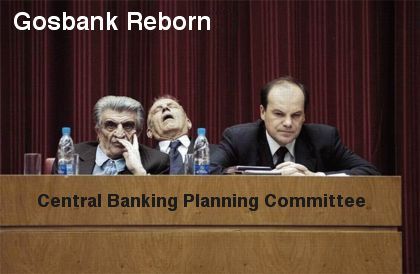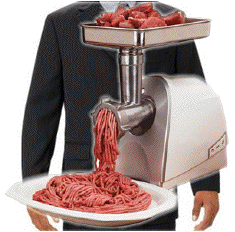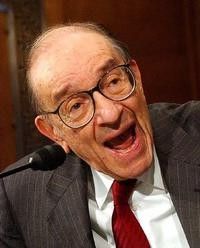 |
Today the GSEs Fannie Mae and Freddie Mac merged with the Federal Reserve Bank, the US Treasury Department, Goldman Sachs, Citigroup and JP Morgan Chase to form Gosbank USA. The DJIA rose 280 points on the news.
Capping a year of crisis in the credit markets and global financial system that led to the nationalization of banks in Europe and England, the US today consolidated and merged ownership of the nation’s largest banks under co-chairmen former Federal Reserve Chairman Ben Bernanke and former Treasury Secretary and ex-head of investment banking giant Goldman Sachs Henry Paulson. “We made lemons out of lemon-aid and turned a terrible crisis for the US economy and the American people into a golden opportunity to expand the power and reach of the State,” said Paulson in a speech made today from the new headquarters of Gosbank USA on Wall Street, the new administrative center for several recently created US government planning authorities, including Gosfin USA, the State Central Financial Regulatory Authority, and Gosrec USA, the State Central Housing Reconstruction Authority.
The new bank gets its name from the Soviet era Gosbank.
Gosbank (Gosudarstvenny bank SSSR—the USSR State Bank) was the central bank of the Soviet Union and the only bank whatsoever in the entire Union from the 1930s until the year 1987. Gosbank was one of the three Soviet economic authorities, the other two being "Gosplan" (the State Planning Committee) and "Gossnab," the State Committee for Material Technical Supply.
The Soviet state used Gosbank primarily as a tool to impose centralized control upon industry in general, using bank balances and transaction histories to monitor the activity of individual concerns and their compliance with Plans and directives. Gosbank did not act as a commercial bank in regard to the profit motive. It acted, theoretically, as an instrument of government policy. Instead of independently and impartially assessing the creditworthiness of the borrower, Gosbank provided loan funds to favored individuals, groups and industries as directed by the central government. - WikiPedia: Gosbank
One of the first initiatives for the new bank is to restructure loans made to borrowers during the housing bubble to extend the payment periods from 30 to 100 years under a new federal government loan program called "Debt for Life."The Soviet state used Gosbank primarily as a tool to impose centralized control upon industry in general, using bank balances and transaction histories to monitor the activity of individual concerns and their compliance with Plans and directives. Gosbank did not act as a commercial bank in regard to the profit motive. It acted, theoretically, as an instrument of government policy. Instead of independently and impartially assessing the creditworthiness of the borrower, Gosbank provided loan funds to favored individuals, groups and industries as directed by the central government. - WikiPedia: Gosbank
“We’re reading your email, you work for a company that manufactures weapons or other goods for the government or you will soon enough, and now we’re managing your investments and loaning you the money you need to eat and put a roof over your head. You work in our companies and you live in our houses. It just doesn’t get any better than this,” remarked Paulson.
President Bush applauded the formation of the new bank as key to restoring confidence in financial markets.
(Hat tip to iTuliper krakknisse for the pointer to Gosbank.)
 |
In response to the 30% surge in demand at food banks around the country this year, fast food giant MacDonalds yesterday began selling its heavily promoted Bernanke Burger and Paulson Paddy meals “Made from the meat of bankers” and sold at cost, US$0.50. In the first day of sales the heavily discounted food items sold out at all 5,200 store locations where the promotion was offered.
"We are pleased with the response," said MacDonalds spokesperson Matt Greedly. "In focus groups the product did very well, although we did have a few participants who threw the items rather than eat them. We are seeing some of that now."
At fifty cents, groups of customers are buying the product and conducting group activity they call "throw-ins" where the burgers are tossed at passing cars driven by mortgage bankers. "You're next!" yelled recently foreclosed on Sacramento, California resident, who asked to not be identified, as an executive from Countrywide drove out of the parking lot in a silver Mercedes.
Most customers polled said that the low price is the primary reason for the items’ popularity rather than the meat source. One customer told us, “The burgers are really tasty. It's as if the animals they're made from have been fed foi gras or something.”
 |
Apologizes for wrecking world economy, admits "harebrained" scheme of credit-dependent economic growth "a failure."
Two years ago April 1, 2006 iTulip published this article and dated it April 1, 2008. Thought we’d re-post it to see how well the prediction conformed to fact two years later. What can we say?
Today, speaking to a group of unemployed automobile parts factory workers in Ohio and homeless ex-venture capitalists in California's once economically vibrant Silicon Valley via a free Internet seminar, ex-Fed Chairman Alan Greenspan apologized for creating a “madcap” economic system in the mid 1990s, dependent on leverage and asset speculation, that collapsed in 2007.
In unusually comprehensible comments during his seminar, Greenspan said, “We thought we had it right. Similar harebrained credit based monetary schemes had been tried before over the past thousand years or so. They didn’t work out, either. Looking back, our mistake was that we didn’t see the obvious parallels to the past. We thought we finally got it right, we’d ironed out the bugs. But things got out of control."
A seminar participant asked Greenspan during a brief Q&A session what led him to conclude that something was wrong. Greenspan replied, "Mortgage companies were financing speculators to flip condos in Florida four times before they were built. Private equity firms were financing speculators to flip $1B companies over and over. The money poured into big houses in Connecticut and upstate New York, hedge funds in the Cayman Islands, even yard sale junk on the Antiques Roadshow. At the end of one show, a guy who brought a crap wooden horse he inherited from his grandparents is surprised when the appraiser tells him it's worth $50,000. You can see the guy is thinking, Who’d pay $50,000 for a crap wooden horse? But I knew. A hedge fund manager, that’s who."
"That and the fact that the Fed's email spam filtering system became completely clogged with 'Refinance Your Home Now Before Rates Go Up!' and 'Consolidate Debt Now!' email," Greenspan added.
“The system was absurd. It’s not Ben’s fault,” Greenspan added. “It’s my fault. The system was stupid, a failure”
Fed Chairman Ben Bernanke, who took over for Greenspan in 2006, commented, “I got this job because of my strong academic credentials as a scholar of The Great Depression. I got a lot of press on this. ‘Bernanke is a student of The Great Depression.’ We made sure this got reported over and over. New York Times, Wall Street Journal, and so on. Get it? Everyone knew I had a big challenge on my hands. Lately I’ve been studying up on the collapse of the Weimar Republic.” - iTulip April 1, 2006
iTulip Select: The Investment Thesis for the Next Cycle™In unusually comprehensible comments during his seminar, Greenspan said, “We thought we had it right. Similar harebrained credit based monetary schemes had been tried before over the past thousand years or so. They didn’t work out, either. Looking back, our mistake was that we didn’t see the obvious parallels to the past. We thought we finally got it right, we’d ironed out the bugs. But things got out of control."
A seminar participant asked Greenspan during a brief Q&A session what led him to conclude that something was wrong. Greenspan replied, "Mortgage companies were financing speculators to flip condos in Florida four times before they were built. Private equity firms were financing speculators to flip $1B companies over and over. The money poured into big houses in Connecticut and upstate New York, hedge funds in the Cayman Islands, even yard sale junk on the Antiques Roadshow. At the end of one show, a guy who brought a crap wooden horse he inherited from his grandparents is surprised when the appraiser tells him it's worth $50,000. You can see the guy is thinking, Who’d pay $50,000 for a crap wooden horse? But I knew. A hedge fund manager, that’s who."
"That and the fact that the Fed's email spam filtering system became completely clogged with 'Refinance Your Home Now Before Rates Go Up!' and 'Consolidate Debt Now!' email," Greenspan added.
“The system was absurd. It’s not Ben’s fault,” Greenspan added. “It’s my fault. The system was stupid, a failure”
Fed Chairman Ben Bernanke, who took over for Greenspan in 2006, commented, “I got this job because of my strong academic credentials as a scholar of The Great Depression. I got a lot of press on this. ‘Bernanke is a student of The Great Depression.’ We made sure this got reported over and over. New York Times, Wall Street Journal, and so on. Get it? Everyone knew I had a big challenge on my hands. Lately I’ve been studying up on the collapse of the Weimar Republic.” - iTulip April 1, 2006
__________________________________________________
To receive the iTulip Newsletter or iTulip Alerts, Join our FREE Email Mailing List
Copyright © iTulip, Inc. 1998 - 2007 All Rights Reserved
All information provided "as is" for informational purposes only, not intended for trading purposes or advice. Nothing appearing on this website should be considered a recommendation to buy or to sell any security or related financial instrument. iTulip, Inc. is not liable for any informational errors, incompleteness, or delays, or for any actions taken in reliance on information contained herein. Full Disclaimer


Comment